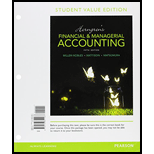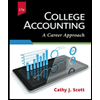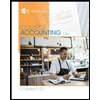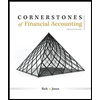
Concept explainers
Which account does a merchandiser use that a service company does not use?
- a. Cost of Goods Sold
- b. Merchandise Inventory
- c. Sales Revenue
- d. All of the above
Merchandise Business: Merchandise business refers to the business of buying goods from the suppliers, and selling those to the customers with profit.
To Find: The correct account that is used in a merchandise company.
Answer to Problem 1QC
Explanation of Solution
Explanation for correct answer:
Merchandise Company uses cost of goods sold account, sales revenue account, and merchandise inventory account to calculate its gross profit. However, Service Company uses service revenue account and operating expenses account to calculate its gross profit.
Explanation for incorrect answers:
- Option (a) is incorrect because only cost of goods sold account is not use in a merchandise company.
- Option (b) is incorrect because only merchandise inventory account is not use in a merchandise company.
- Option (c) is incorrect because only sales revenue account is not use in a merchandise company.
Want to see more full solutions like this?
Chapter 5 Solutions
Horngren's Financial & Managerial Accounting, Student Value Edition Plus MyLab Accounting with Pearson eText -- Access Card Package (5th Edition)
- Indigo Corporation purchased trading investment bonds for $65,000 at par. At December 31, Indigo received annual interest of $2,600, and the fair value of the bonds was $62,200. Prepare Indigo' journal entries for (a) the purchase of the investment, (b) the interest received, and (c) the fair value adjustment. (Assume a zero balance in the Fair Value Adjustment account.) (List all debit entries before credit entries. Credit account titles are automatically indented when amount is entered. Do not indent manually. If no entry is required, select "No Entry" for the account titles and enter O for the amounts.) No. Account Titles and Explanation Debit Credit (a) (b) (c)arrow_forwardSwifty Corporation purchased trading investment bonds for $40,000 at par. At December 31, Swifty received annual interest of $1,600, and the fair value of the bonds was $37,600. Prepare Swifty' journal entries for (a) the purchase of the investment, (b) the interest received, and (c) the fair value adjustment. (Assume a zero balance in the Fair Value Adjustment account.) (List all debit entries before credit entries. Credit account titles are automatically indented when amount is entered. Do not indent manually. If no entry is required, select "No Entry" for the account titles and enter O for the amounts.) No. Account Titles and Explanation Debit Credit (a) (b) (c)arrow_forwardabout investment securities owned by a company, what do we mean by “significant influence”?arrow_forward
- what is the working capital?arrow_forwardStatement of Financial position as at September 30 for 2023 and 2024 Assets 2023 2024 Cash and equivalents………………………………………. $56,100 $37,694 Receivables, Trade, less allowances of $1,104 and $991 respectively 47,753 37,645 Other Receivables…………………………………………………… 233 516 Inventories…………………………………………………………… 29,587 23,202 Prepaid expenses and other………………………………………….. 4,739 4,143 Total current assets…………………………………………………... 138,412 103,200 Property, plant and equipment, at cost………………………………. 314,880 298,609 Less accumulated depreciation………………………………………. (225,406) (211,494) Property, plant and equipment net…………………………………… 89,474 87,115 Other assets Goodwill……………………………………………………………...…arrow_forwardSwifty Corporation had 2025 net income of $1,169,000. During 2025, Swifty paid a dividend of $2 per share on 87,850 shares of preferred stock. During 2025, Swifty had outstanding 301,000 shares of common stock. Compute Swifty's 2025 earnings per share. (Round answer to 2 decimal places, e.g. 3.56.) Earnings per share GA $ per sharearrow_forward
- GFH Decorators, a partnership, had the income and expenses shown in the spreadsheet below for the current tax year. Identify whether each item is an "Ordinary Business Income" item (reported on Page 1, Form 1065), a "Separately Stated Item" (reported on Schedule K, Form 1065), or both. Enter the value of ordinary income items in column C and the value of separately stated items in column D. Note that not all the cells in either column C or D will have values. If a response is zero, leave the cell blank.Use a minus sign to enter negative values. A B C D 1 Ordinary Business Income Separately Stated Items 2 Fee revenue $600,000 3 Dividend income $2,000 4 Capital gain distributions $10,000 5 Charitable contributions (cash) ($500) 6 Salaries to employees ($150,000) 7 Partner guaranteed payments ($75,000) 8 MACRS depreciation on office furniture ($3,000) 9 Total ordinary business income $0arrow_forwardexplain why preferred stock is referred to as a "hybrid security"?arrow_forwardBriefly recap what is meant by "the preemptive right to purchase common stock"? Explain the concept of Stock-Appreciation Rights (SARs).arrow_forward
- What's the difference between calculating EPS for a simple capital structure versus a complex capital structure?arrow_forwardIn the first two years of operations, a company reports taxable income of $115,000 and $165,000, respectively. In the first two years, the tax rates were 38% and 32% respectively. It is now the end of the third year, and the company has a loss of $160,000 for tax purposes. The company carries losses to the earliest year possible. The tax rate is currently 25%. Required How much tax was paid in year 1 and year 2? Compute the amount of income tax payable or receivable in the current (third) year.arrow_forwardQuestion 22 (18 points) Problem 2 – Accounting Changes (18 marks) During the audit of Hoppy Ending Brewery for the fiscal year ended June 30, 2027, the auditors identified the following issues: a. The company sells beer for $1 each plus $0.10 deposit on each bottle. The deposit collected is payable to the provincial recycling agency. During 2026, the company had recorded $12,000 of deposits as revenue. The auditors believe this amount should have been recorded as a liability. b. The company had been using the first-in, first-out cost flow assumption for its inventories. In fiscal 2027, management decided to switch to the weighted-average method. This change reduced inventory by $25,000 at June 30, 2026, and $40,000 at June 30, 2027. c. The company has equipment costing $6,000,000 that it has been depreciating over 10 years on a straight-line basis. The depreciation for fiscal 2026 was $600,000 and accumulated depreciation on June 30,…arrow_forward
- Principles of Accounting Volume 1AccountingISBN:9781947172685Author:OpenStaxPublisher:OpenStax College
 College Accounting (Book Only): A Career ApproachAccountingISBN:9781337280570Author:Scott, Cathy J.Publisher:South-Western College Pub
College Accounting (Book Only): A Career ApproachAccountingISBN:9781337280570Author:Scott, Cathy J.Publisher:South-Western College Pub College Accounting, Chapters 1-27AccountingISBN:9781337794756Author:HEINTZ, James A.Publisher:Cengage Learning,
College Accounting, Chapters 1-27AccountingISBN:9781337794756Author:HEINTZ, James A.Publisher:Cengage Learning, - Principles of Accounting Volume 2AccountingISBN:9781947172609Author:OpenStaxPublisher:OpenStax College
 Cornerstones of Financial AccountingAccountingISBN:9781337690881Author:Jay Rich, Jeff JonesPublisher:Cengage LearningCentury 21 Accounting Multicolumn JournalAccountingISBN:9781337679503Author:GilbertsonPublisher:Cengage
Cornerstones of Financial AccountingAccountingISBN:9781337690881Author:Jay Rich, Jeff JonesPublisher:Cengage LearningCentury 21 Accounting Multicolumn JournalAccountingISBN:9781337679503Author:GilbertsonPublisher:Cengage





